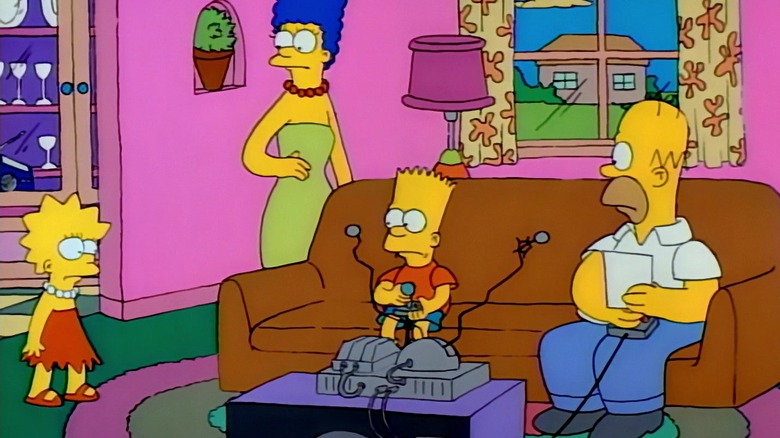Matt Groening May Have Created The Simpsons, But Twelve Unsung Heroes Made It A Hit
In 1977, aspiring cartoonist Matt Groening moved from his hometown of Portland, Oregon to Los Angeles with dreams of becoming a writer. Like most people who move to Los Angeles with dreams of becoming a writer, he took on some of the most menial jobs imaginable. Groening worked in a sewage treatment plant, as a dishwasher, and as a waiter. All the while, Groening worked on what would become his signature creation, the "Life in Hell" comic strip.
Groening would leave "Life in Hell" comics in a small corner of Licorice Pizza, the celebrated Los Angeles record store where he occasionally worked. It was an embittered strip about modern life, a harsh critique of life, love, school, and work. Groening attacked everything the establishment celebrated as normal and good, finding nothing but misery in the real world.
"Life in Hell" was picked up by Wet Magazine and, later the Los Angeles Reader. With so many eyeballs on "Life in Hell," it was likely that a celebrity or a producer would see it ... which is exactly what happened. James L. Brooks was a fan of "Life in Hell" and his contact with Groening eventually led to the creation of the "Simpsons" animated bumpers for "The Tracy Ullman Show." Those bumpers were subsequently expanded into an animated sitcom that debuted in 1989. As of this writing, "The Simpsons" has lasted well over 10 episodes.
"The Simpsons" may have been created by Groening, and a lot of media surrounding the show back in the early 1990s touted the show as a "lone wolf" success story wherein an underground artist broke through. However, the book "Springfield Confidential" by Mike Reiss and Mathew Klickstein presents a different narrative, revealing "The Simpsons" would not have been possible without a dozen separate artists all working together.
Sam, George, Jim
During the early days of "The Simpsons," Matt Groening was the sole artist getting all the credit, and it was Groening who was being invited onto the radio and TV to talk about the series. In truth, as "Springfield Confidential" explains, Groening's collaborator Sam Simon was pivotal in developing the series. Simon served as showrunner on "The Simpsons" for its first few years, designed multiple characters (he's behind Mr. Burns), and wrote several episodes. Yet his name was never mentioned in "Simpsons" reporting early on. The story goes that Simon resented that he never got credit and began to treat Groening poorly behind the scenes as a result. Simon left the show in 1993 but continued to get an executive producer credit. He passed in 2015, and "The Simpsons" still bears his name. "If Matt is Thomas Edison inventing the lightbulb," Reiss points out, "Sam is George Westinghouse, building the factory to crank the bulbs out."
"Springfield Confidential" also notes that Simon was only one of the behind-the-scenes masterminds of "The Simpsons," and that trying to nail down the "singular genius" responsible for the show's existence is impossible. After Groening and Simon, Reiss calls attention to writer George Meyer, who served as a vital gag writer for the show. Meyer was eventually profiled in the New Yorker and wrote 12 "Simpsons" episodes in addition to co-penning "The Simpsons Movie." He left the show in 2005.
Reiss also credits Brooks, the man who gave Groening his platform and still serves as an executive producer on "The Simpsons" to this day. According to Reiss, Brooks was the one who made the "Simpsons" characters into real people with dramatic concerns, freeing them from being mere "slob" archetypes.
Dave, Al, Dan, Julie, Nancy, Yeardley, Hank, and Harry
Reiss is also careful to credit David Silverman, an animator and prolific "Simpsons" director. Silverman was on board from the start, serving as an animator for the original "Simpsons" bumpers for "The Tracy Ullman Show." He directed 24 episodes of the series proper (including the original 1989 TV special that kicked off the show in earnest), "The Simpsons Movie," and the Oscar-nominated "Simpsons" short film "The Longest Daycare." Silverman left "The Simpsons" from 1997 to 2001 to work on other animation projects, but has been back on board ever since his hiatus, serving as a consulting producer, an executive consultant, a title designer, a character layout artist, a storyboard artist-slash-consultant-slash-revisionist, the designer of the show's main titles, a background designer, and author of the "Spider-Pig" song.
Also in Reiss' hymnal of songs and praise is Al Jean, showrunner for 717 of the show's 762 episodes. He's one of the central producers and masterminds, and "The Simpsons" wouldn't exist without him. Jean helped define all animation in the 1990s.
And, of course, Reiss gives credit to the long-term voice cast of "The Simpsons" that has remained consistent throughout its decades-long tenure. Nancy Cartwright, Yeardley Smith, Julie Kavner, Dan Castellaneta, Hank Azaria, and Harry Shearer have come to define "The Simpsons" as much as any of the writers and producers. One can hardly imagine any one of them leaving the series and having it feel the same (although Shearer almost left over a pay dispute in 2015).
All told, that's a dozen masterminds. It takes a village to build a Springfield.


